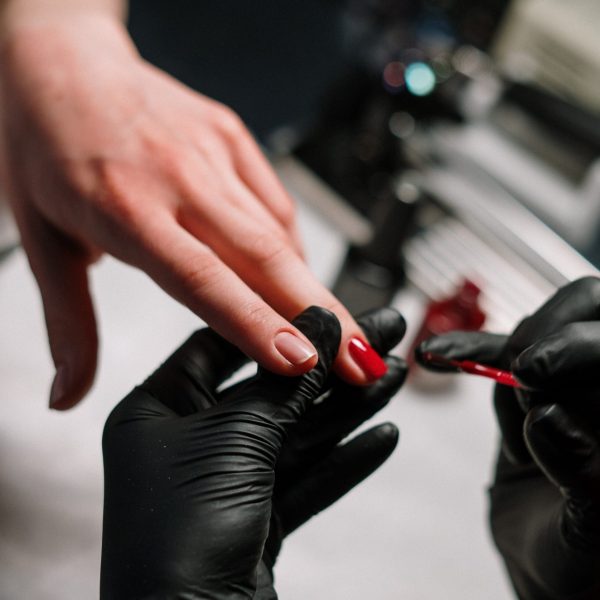- Did you ever think your perfectly manicured fingernails with that chic new nail polish might be contributing to a hormone imbalance? If you use a conventional brand of nail polish, you may want to consider its impact on your fertility health and hormonal balance.
The key to optimal fertility and getting pregnant is to have balanced hormones. Many cosmetics and body care products contain ingredients called xenohormones, some of which are known to mimic estrogen in the body (xenoestrogens). Xenohormones contribute to hormonal imbalance and fertility health problems by disrupting the normal balance of hormone levels in the body. Nail polish is one of many cosmetic products that has been found to contain ingredients that elicit a strong hormonal effect.
Hormone Harming Ingredients
Within the past decade a popular nail polish ingredient, dibutyl phthalate (DBP – helps make plastic flexible), was determined to be a developmental toxin and as a result listed as such by the state of California and banned from cosmetics in Europe. Many cosmetic brands replaced DBP with what was thought to be a healthier alternative organophosphate called triphenyl phosphate (TPHP or TPP). TPHP is now under scrutiny and what is being learned is that it too is a developmental toxin. In fact, the Environmental Working Group (EWG) lists TPHP as an endocrine-disrupting chemical.
Both phthalates and organophosphates have been found through both animal and some limited human studies to alter reproductive health in the following ways:
- disrupt sex-hormone balance
- inhibit estrogen metabolism
- suppress estradiol production by the ovaries which can lead to anovulation
- increase levels of 17β-estradiol (E2)
- increase testosterone (in male fish)
The Research
One small study is making headlines, the results of which are part of what prompted the EWG to review and update the rankings of the chemicals found in nail polishes and nail treatments on their Skin Deep Cosmetics Database. The October 2015 study published in the journal Environment International by researchers at Duke University (in which the EWG participated), found that all of the 26 female participants who applied a conventional brand of nail polish (found in major department stores or pharmacies), had TPHP in their urine. In fact, TPHP levels were “found to increase nearly seven-fold 10-14h [hours] after fingernail painting…” as determined by urine samples after nails were painted versus urine samples taken prior to nail painting.
This study’s findings determined topical exposure of phthalates should be of as much concern as environmental via inhalation. What is alarming with this study’s findings is that it was based on only one application of nail polish. The authors concluded that, “Our results indicate that nail polish may be a significant source of short-term TPHP exposure and a source of chronic exposure for frequent users or those occupationally exposed.”
Many other animal studies have proven topical and inhaled exposure to organophosphates is highly, acutely toxic, meaning these chemicals are known to impact the body with just one single exposure, or from multiple exposures in a short amount of time (usually within 24 hours).
As far back as 1975, more than 40 years ago, researchers determined that “chronic, occupational exposure to high levels of phthalates is associated with decreased rates of pregnancy and higher rates of miscarriage” in human females and in 1999 one study concluded that “higher urinary phthalate levels correlated with pregnancy complications such as anemia, toxemia, and preeclampsia in women living near a plastics manufacturer.”
What You Can Do
Women expose themselves to phthalates via beauty, body care, and personal products on a daily basis. If you hadn’t thought your nail polish could contribute to hormone imbalance, it’s time to do so. For more information about toxins in body care products and xenohormones, how to avoid them and find alternative product choices, please visit our articles:
Elevated Estrogen Levels Linked to Toxins in Body Care Products
Xenohormones: Causing a Hormone Imbalance Epidemic
- Congleton, J. (2015, October 19). New Report: NAILED: Endocrine Disruptor In Nail Polish Gets Into Women’s Bodies. Retrieved from: http://www.ewg.org/research/nailed
- Hawthorne, M. (2015, October 23). Triphenyl phosphate, found in ‘eco-friendly’ nail polish, spurs worries. Retrieved from: http://www.chicagotribune.com/news/watchdog/ct-nail-polish-toxic-chemical-20151023-story.html
- Liu, X., Ji, K., & Choi, K. (2012). Endocrine disruption potentials of organophosphate flame retardants and related mechanisms in H295R and MVLN cell lines and in zebrafish. Aquatic Toxicology, 114-115, 173-181. doi:10.1016/j.aquatox.2012.02.019. Retrieved from: https://www.sciencedirect.com/science/article/pii/S0166445X12000690
- Lovekamp-Swan, T., & Davis, B. J. (2003). Mechanisms of phthalate ester toxicity in the female reproductive system. Environmental Health Perspectives, 111(2), 139-145. doi:10.1289/ehp.5658. Retrieved from: https://www.ncbi.nlm.nih.gov/pmc/articles/PMC1241340/
- Mendelsohn, E., Hagopian, A., Hoffman, K., Butt, C. M., Lorenzo, A., Congleton, J., . . . Stapleton, H. M. (2016). Nail polish as a source of exposure to triphenyl phosphate. Environment International, 86, 45-51. doi:10.1016/j.envint.2015.10.005. Retrieved from: https://www.sciencedirect.com/science/article/pii/S0160412015300714?via%3Dihub





